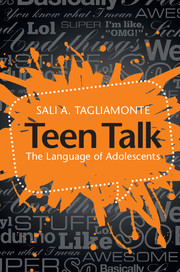Book contents
- Frontmatter
- Dedication
- Contents
- List of figures
- List of tables
- Preface
- 1 What's all the fuss about teen language?
- 2 Teens talking
- 3 Methods: how to tap teen language?
- 4 Quotatives: I'm like,“Oh my God!”
- 5 Intensifiers: upping the ante – super cool!
- 6 How do you start a sentence?
- 7 Sentence enders: finish with a flourish
- 8 Generics: stuffology
- 9 Just: just what?
- 10 Adjectives: the good, bad, and lovely
- 11 Other funky teenage features: You know what? I dunno. Whatever!
- 12 Internet language: everyone's online
- 13 Are they always going to talk like that?
- Notes
- References
- Author index
- Keyword index
2 - Teens talking
Published online by Cambridge University Press: 05 June 2016
- Frontmatter
- Dedication
- Contents
- List of figures
- List of tables
- Preface
- 1 What's all the fuss about teen language?
- 2 Teens talking
- 3 Methods: how to tap teen language?
- 4 Quotatives: I'm like,“Oh my God!”
- 5 Intensifiers: upping the ante – super cool!
- 6 How do you start a sentence?
- 7 Sentence enders: finish with a flourish
- 8 Generics: stuffology
- 9 Just: just what?
- 10 Adjectives: the good, bad, and lovely
- 11 Other funky teenage features: You know what? I dunno. Whatever!
- 12 Internet language: everyone's online
- 13 Are they always going to talk like that?
- Notes
- References
- Author index
- Keyword index
Summary
I think the natural inclination of anybody is to get lazy and sloppy and not think. So there's more and more slang and people dropping their G's and things like that that frankly grates on me. I hate it! Then again, I find myself doing it sometimes.
(Sara Kempt, 49)In this chapter I introduce the data from which the book will draw its information. I will also describe the data collection methods and procedures, the fieldwork experiences, and corpus compilation procedures. Who are the teenagers and young adults who make up the animated conversations I cite? Readers will get to know them through the many examples of their conversations in this chapter and sprinkled throughout the book.
When people talk about teen language, they often have based their views on anecdotal observation and/or extrapolation from small samples. In this book, I rely on an immense collection of conversations that were collected under unique circumstances – teenagers talking to first-year university students who were familiar to them.
The data come from a research program that I have been conducting for many years. The earliest data I will discuss come from 1995; the latest from 2010. The corpora span many different projects, most of them conducted within the auspices of the undergraduate curriculum of universities where I have taught over this period (the University of Ottawa, the University of York, UK, and the University of Toronto). In order to study teen language, it is important to be able to situate it more broadly. How can you say that a word or an expression is a “teen” thing if you do not know what everyone else in the community is doing? How do you know it's a “new” thing if you haven't checked the historical record? A researcher must have a solid comparative perspective from people of other ages and other times and places. Without the comparative perspective from across the age span, something that seems exclusive to teenagers may actually be a development that began a long time ago among people much older than contemporary teens. For example, everyone thinks that like is a teenage thing, or at least a young person's thing.
- Type
- Chapter
- Information
- Teen TalkThe Language of Adolescents, pp. 8 - 42Publisher: Cambridge University PressPrint publication year: 2016

